Patreon is a popular platform among content creators and artists. It allows them to connect with their fans and receive ongoing financial support from their supporters to fund their work. Patreon comes with benefits like zero upfront costs (you can create a page for free) and multiple membership options. However, it also has some disadvantages, like privacy issues, changing policies, and a lack of built-in marketing tools. This is why many creators are looking for Patreon alternatives. If you’re one of them, you’re in the right place.
In this article, we’ll cover 15 of the top Patreon alternatives and look at their features and pricing options in-depth so that you can decide the best platform for you.
Check Out Our Video Guide of the Best Patreon Alternatives:
What To Look for in a Patreon Alternative?
Here are five things to keep in mind when looking for a Patreon alternative.
- Does the platform have a robust community where you can promote your content and receive feedback from other creators and members to improve your offerings?
- Is the platform equipped with effective marketing tools (i.e., email lists, promo offers, discounts, and integrations with social media apps) to help attract new audiences and grow your subscriber list while keeping the existing ones engaged?
- Does the platform offer easy, fast, and secure payment options that allow your audience to purchase your work as soon as it is released without worrying about their safety?
- Are there high subscription fees and low payouts for creators? Does the platform charge any hidden fees or excessive commissions?
- Does it provide access to analytic reports that can help you understand more about your audience and what they are looking for so that you can tailor your content strategy accordingly?
What Are Some of the Best Alternatives to Patreon?
Here are the top 15 Patreon alternatives you can consider if you are trying to find something that will provide a little more upside in certain areas than Patreon will.
1. Kickstarter
Kickstarter is one of the most popular crowdfunding platforms. Creators can put up their campaigns as one-time projects (as opposed to recurring projects that other platforms offer) and raise money for them.
Launching a campaign requires introducing your product, creating a funding goal, and setting a time frame to fulfill that goal. Supporters can then pledge money and make your project a reality.
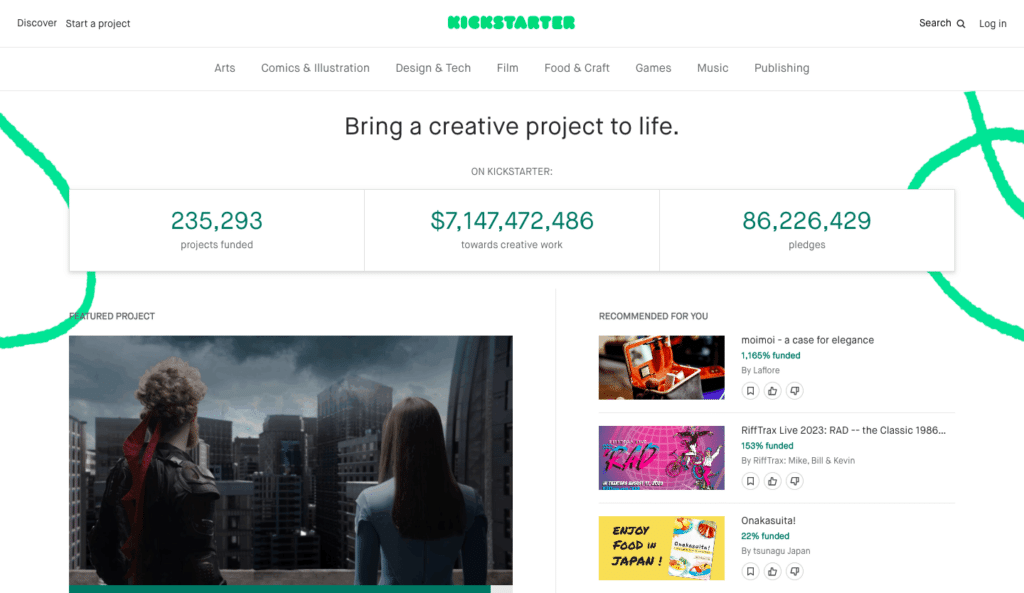
Pros:
- An active and large user base that makes it easy for you to reach out to a lot of supporters.
- Lots of creative categories like art, film, technology, music, craft, and more.
- Valuable resources and tools like mobile app and project editor, and comprehensive guidelines to create a project.
- Creators can reward their supporters with personalized merchandise or early bird access to their products.
Cons:
- It’s an all-or-nothing model where creators must meet the funding goal to receive their supporters’ money.
- Projects may not succeed, despite marketing, due to heavy competition in the market.
- Doesn’t take responsibility for projects delivering on their promises, so backers may get disappointed.
- Review process takes around 3-5 days, so creators must ensure they put their project on Kickstarter 7 days or more before launch.
Pricing:
- 5% fee on raised funds + payment processing fees which can vary from country to country but is generally around 3-5%.
- No charge for creating a project on their platform.
Best For:
- Users with a well-formed idea and who want to crowdfund their projects like innovative products, games, books, and music albums.
2. Indiegogo
Indiegogo launched its platform in 2008 and since then has helped launch over 800,000 projects. Every month 19,000 crowdfunding campaigns are launched on its website. Here’s what you can expect when you use Indiegogo.
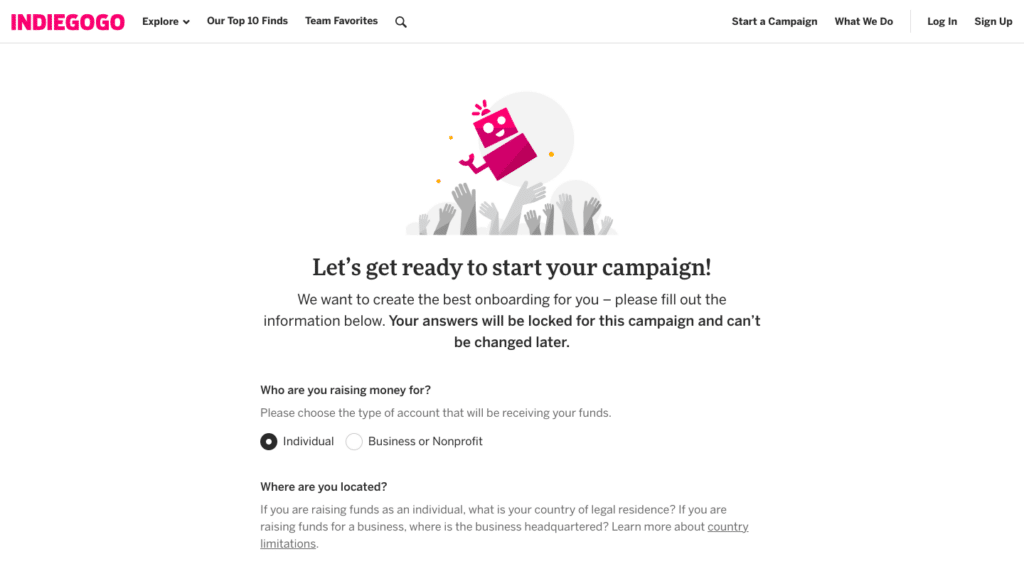
Pros:
- Can continue to raise funds beyond your funding goal via their InDemand program.
- Two types of funding: “fixed” and “flexible.”
- Fixed funding requires you to exceed the fundraising goal to receive the raised money.
- Flexible allows you to receive the money even if you don’t achieve your fundraising goal.
- Can raise money for charity with GoFundMe.
- Applicants don’t have to wait for approval from the Indiegogo team–projects are instantly approved, and there’s no time wasted in pre-screening.
- Partnerships with manufacturing, fulfillment, and retailers simplify product delivery.
Cons:
- If you have promised your backers some rewards or incentives, you have to give them out whether you raise the money to ship your project or not.
- Backer community isn’t as huge as Kickstarter, so you may see less discoverability.
Pricing:
- A platform fee of 5% + third-party credit card fees of 2.9% + $0.30 for USD payout (extra third-party fees may apply).
Best For:
- Users who want to raise funds for various projects like art, music, games, tech, and charity or those who may be interested in offering backers a share of their business in return for their investment.
3. Podia
Podia is a digital platform for creators to sell and market their online courses, workshops, and memberships, as well as offer digital downloads of their ebooks, audio lessons, webinars, and more.
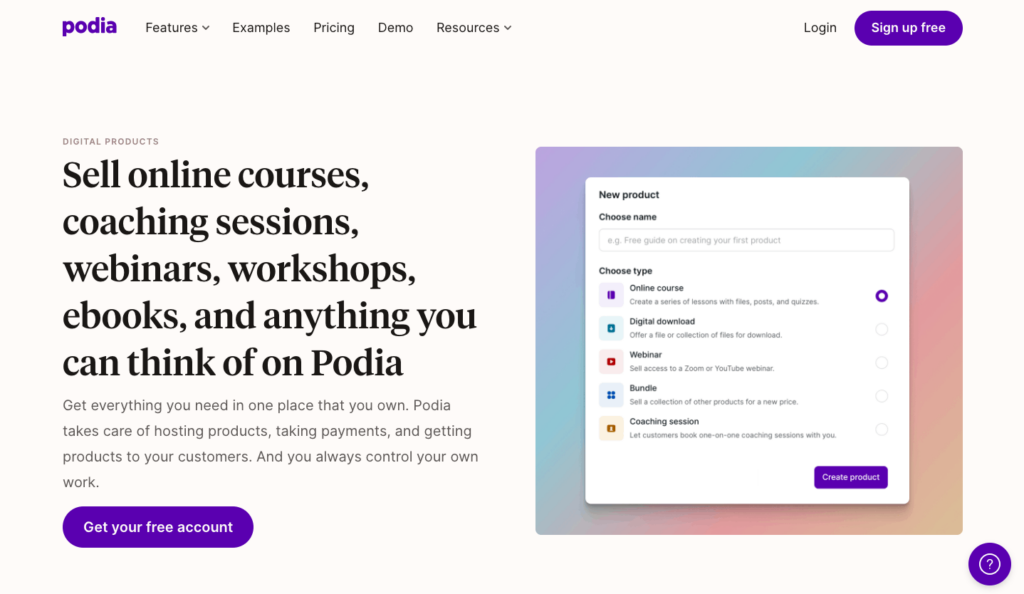
Pros:
- Integrated email marketing feature so you can easily keep in touch with your subscribers.
- Live chat support.
- Functionality to create your own website without having to code.
- Community portal where users can engage better by sharing videos, photos, and 1900 types of embeddable content.
- Tons of resources and free tools to help users get up to speed.
- Free plan that includes one website, one digital download, and unlimited customers.
Cons:
- Affiliate marketing setup is available only for Shaker and above plans.
- Limited customization options when compared to other platforms.
- Lack of email automation and advanced email personalization.
- No mobile app as of now.
- No shipping or inventory management support for physical products.
Pricing:
- Podia has various pricing plans starting from $39 to $89 per month (these vary when you choose an annual plan).
Best For:
- Creators who want to sell digital products.
4. Sellfy
Sellfy is an ecommerce platform that lets users directly sell their digital and physical products.

Pros:
- Easy store setup–can be done within 5 minutes.
- Built-in marketing features like discount codes, email marketing, ad pixel tracking, and upselling.
- Customization options to match your brand identity.
- Location-based automated language translation and mobile-optimized store functionalities.
- Can sell t-shirts, mugs, hats, and hoodies with a print-on-demand option (fully managed by Sellfy).
Cons:
- Limited app integrations.
- Can use only two payment processors: PayPal and Stripe.
- No feature for affiliate marketing programs.
Pricing:
- No transaction fees.
- Standard charges by PayPal and Stripe that’s around 2.9% + 30¢ for every sale.
- Various pricing plans start from $29 per month to $159 per month.
Best For:
- Users who want to get a store set up done quickly, are just starting out, and want to sell merchandise directly to customers.
5. Buy Me a Coffee
Buy Me a Coffee is a platform for artists, video creators, writers, podcasters, and developers where they can post their work and ask supporters for monthly or yearly donations/ memberships.

Pros:
- Can accept tips from the audience.
- Various marketing tools like an email newsletter, iOS and Android mobile apps, and analytics tools.
- 24/7 live chat support.
- Allows supporters to pay creators and artists without having to sign in.
- All features are available for free (only transaction fees are applied).
- Safe and reliable platform — they even have a bug bounty program to encourage users to report any security issues.
Cons:
- Not suitable for creators looking to earn a full-time income.
- Limited tools to build an audience.
Pricing:
- 5% of all transactions + payment processor’s fee.
- No pricing tiers.
- Creators can set up their own subscription models and accept one-off donations.
Best For:
- Artists looking for a side income or hobby project.
6. Memberful
With a simple interface and customizable membership options, Memberful is a membership platform where users can monetize their content.

Pros:
- Membership programs can be created with various levels of access.
- Integration with popular websites and email marketing services.
- Easy to set up and one-click checkout for customers with Apple Pay and Google Pay.
- Visual customization editor where you can customize your brand colors and logo.
- Membership metrics to check what’s working and what’s not.
- Referral programs and coupons for promotions.
Cons:
- Some users feel that the interface is too basic.
- Limited Customer Management Software options.
- Can only receive payments via Stripe.
Pricing:
- Memberful comes with three pricing plans, ranging from free to $100 per month.
- Transaction fees are reduced for premium subscriptions.
Best For:
- Content creators, educators, podcasters, and writers looking to offer exclusive content to their audience.
7. Hypage
Hypage lets you create a bio link for your work, social media accounts, and other creative projects. Plus, you can sell content, create a membership, accept donations, and allow custom requests.

Pros:
- Zero transaction fees.
- Quick setup to take payments.
- Though it’s a bio-link platform, users can also create gated digital content and courses.
- Zapier and Webhook integration.
Cons:
- Doesn’t come with a drag-and-drop builder.
- Detailed analytics are missing, like traffic over time or audience location.
Pricing:
- Hypage offers two pricing plans: Pro ($19/month) and Enterprise ($39/month)
Best For:
- Small business owners and creative individuals who want to showcase multiple links, sell memberships, or accept donations.
8. Ko-fi
Ko-fi lets creators accept donations from their audience to fund their projects while also letting them create a basic ecommerce storefront.
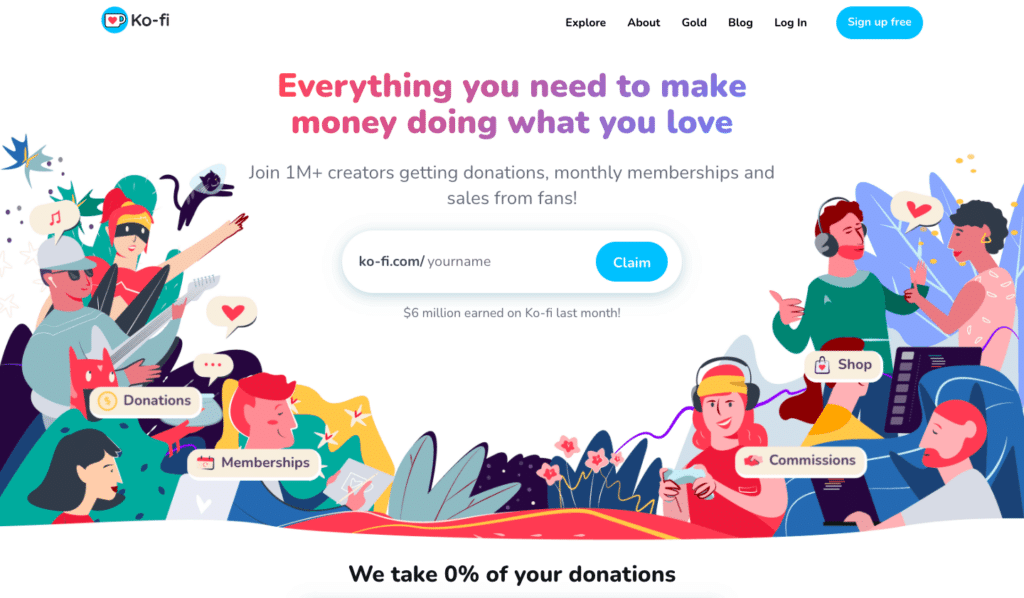
Pros:
- Options for one-time tips or recurring membership-based donations.
- Can sell digital and physical products like prints, stickers, wallpapers, sound files, crafting kits, or books.
- Doesn’t charge platform fees.
- In-stream donation alerts.
Cons
- Limited payout vendors.
- Analytics isn’t available on the free account.
- Donors need to create a Ko-fi account to donate.
- Not a great platform if you want to post blogs or articles regularly — it only has a basic blogging setup.
Pricing:
- 0% platform or commission fees on the free plan.
- 5% fees on payments for memberships, shops, and commissions.
- Advanced features like gated content, hi-res downloads, and shorter usernames require you to upgrade to Ko-fi Gold, which is $6/month when billed annually.
Best For:
- Users who want to accept one-time donations.
9. Substack
Substack is a simple platform for people who write regular blog posts and newsletters and want to distribute them for free or for a fee.
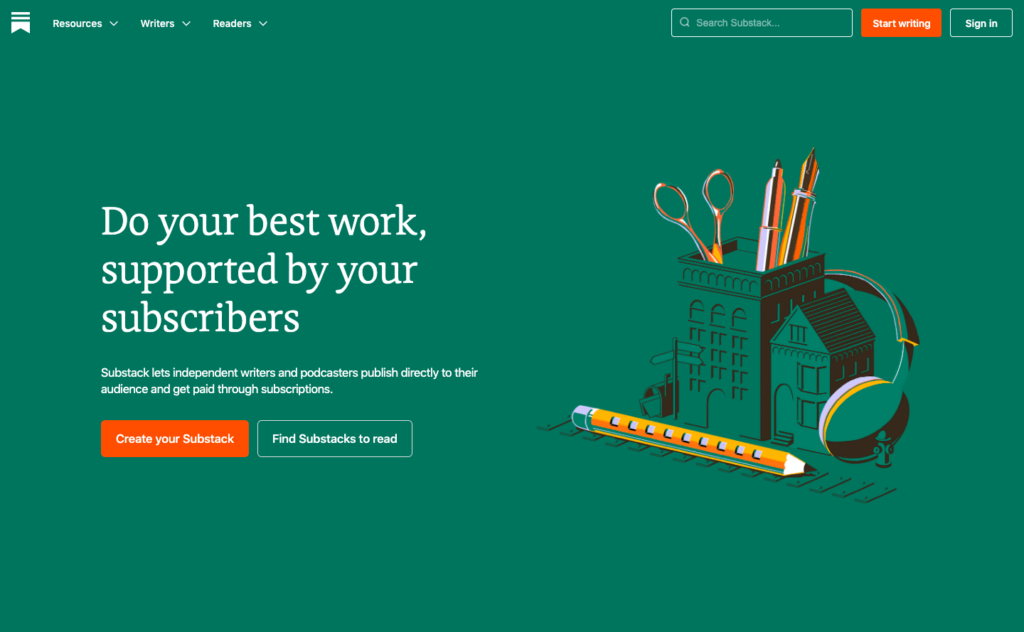
Pros:
- Can sign up with a couple of clicks.
- Easy-to-use writing interface.
- Unlimited free subscribers feature and no platform usage fee.
- Drag and drop elements to add photos, videos, and audio files to your posts.
Cons:
- Limited customization options to design your newsletters.
- May take a lot of work to build your audience, so it’s more suitable for people who already have an email list.
- Doesn’t provide an in-depth traffic analysis.
- Can’t set up automated email campaigns.
- Limited integrations with external platforms.
Pricing:
- Publishing is free.
- For paid subscriptions, there’s a 10% platform fee and a credit card fee charged by Stripe.
Best For:
- Bloggers with a pre-built email list who want to turn their readers into paid subscribers.
10. Kajabi
Kajabi is an all-in-one platform for people wanting to establish online businesses. It lets users design, sell, and market their courses, coaching services, membership websites, and podcasts.

Pros:
- Built-in marketing and sales funnel software so you can create various types of funnels to drive conversions.
- Marketing automations that trigger emails if your subscribers don’t complete a course or other event.
- Creators get their custom domain and full branding functionalities to match the platform to their business.
- Built-in community platform to engage with your audience.
Cons:
- No free plan and pricing is expensive when compared to other platforms.
- Features are suitable if you have a large number of subscribers or course takers; otherwise, they can seem overwhelming.
- Not a great option for small businesses or freelancers as it’s pricey.
Price:
- Kajabi offers three pricing plans: Basic ($149/month), Growth ($199/month), and Pro ($399/month).
- They take a 0% transaction fee, and there’s a free trial available.
Best For:
- High-ticket online courses.
11. Gumroad
Gumroad allows people to easily turn their passion into a business by helping them sell digital products such as music, ebooks, coaching sessions, software, and more. You can even sell physical products and create an appealing online storefront to showcase your products.
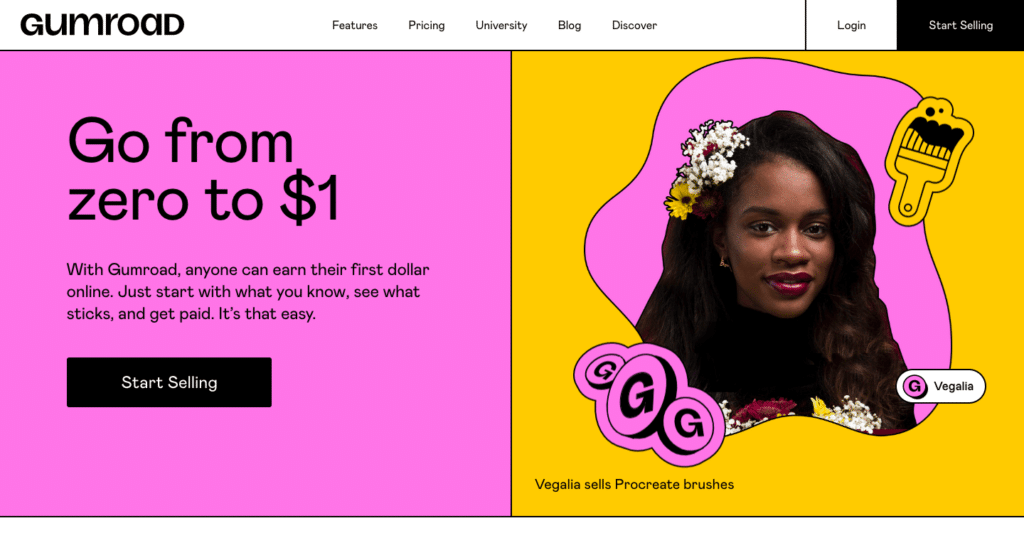
Pros:
- Easy-to-use interface.
- Clean and intuitive checkout pages.
- Powerful analytics and stats feature where you can view product and purchase insights.
- License keys for software products.
- Can create coupons, discount codes, and easy offer codes for “pay what you want.”
- Lots of challenges to keep sellers on their toes, like the 30-day audience-building challenge.
- Pre-order functionality.
Cons:
- High transaction fees for new sellers.
- Requires a minimum balance of $10 for payouts.
- Lacks a built-in email marketing solution.
- Free plan lets you upload file sizes of only 25MB, which can be very restricting.
Pricing:
- No platform or monthly subscription fee.
- 10% fee on every sale.
Best For:
- Creators and artists who want a complete ecommerce platform to sell their digital and physical products.
12. WooCommerce
WooCommerce is a free WordPress ecommerce plugin that is very easy to install. So if you have a WordPress site and want to build an online shop and boost sales, WooCommerce is suited for that.
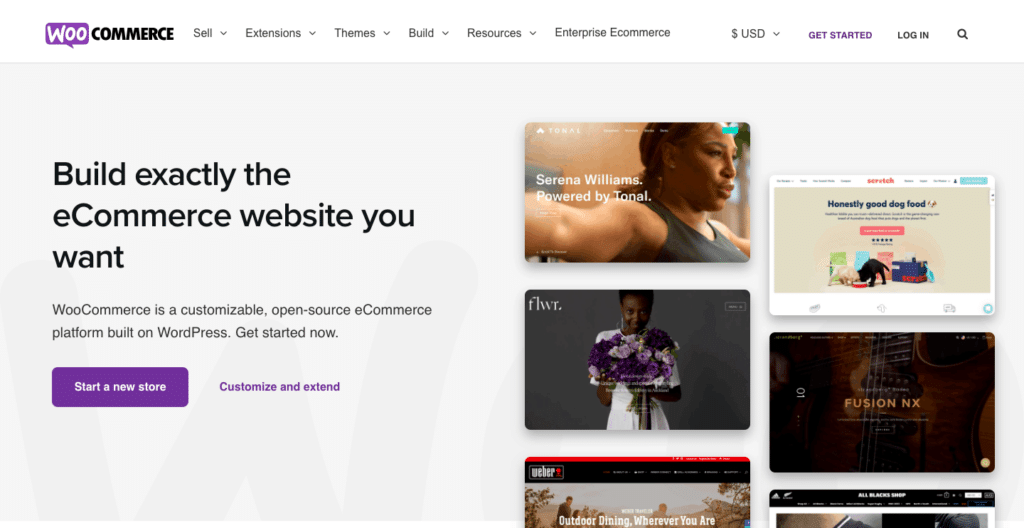
Pros:
- Integrates well with other WordPress plugins.
- Offers full customization.
- Multiple payment options that you can use as integrations.
- Built-in blogging feature because of WordPress.
- Multiple pricing options for your products, like loyalty programs and BOGOs (buy one get one).
- Hundreds of professional-looking themes.
Cons:
- Has a learning curve.
- Maintenance is the user’s responsibility because it’s self-hosted.
- Little dedicated customer support for troubleshooting issues.
Pricing:
- Installing it is free (it’s open source), but you need to pay for a hosting service and a domain name.
Best For:
- Small to medium-sized online businesses that already use WordPress.
13. Mighty Networks
Mighty Networks is an excellent option for people who want to start a community, add a paid membership, create online courses, stream live events, and more.

Pros:
- Chat and feed functionalities to connect in real time.
- Can create content-only or cohort-based courses.
- Run conferences, high ticket mastermind groups, and meetups on Zoom, in-person, or with their native live streaming.
- Can design experiences for new members, like a welcome checklist, introduction, and icebreaker questions.
Cons:
- Limited design options to build landing pages.
- Lack of affiliate programs.
Pricing:
- Mighty Network offers three pricing plans: Community ($33/month), Business ($99/month), and Mighty Pro (price on request).
- A 14-day free trial is available with the first two plans.
Best For:
- People who want to build their communities online.
14. MemberPress
MemberPress is a membership-specific WordPress plugin that lets you sell online courses on your website.

Pros:
- Can create customizable coupons.
- Community building features for better engagement and support.
- Mobile-responsive page builder.
- Can create drip content (timed content rollouts) to make members curious.
- Can decide access level for members.
Cons:
- No free plan.
- No upsell feature.
- Must have a WordPress website to use it.
Pricing:
- Memberpress has three pricing models: Basic ($179.50/year), Plus ($299.50/year), and Pro ($399.50/year).
- Comes with a 100% no-risk refund guarantee if you don’t enjoy their platform.
Best For:
- Creators who already have a WordPress site and want to monetize it while offering various membership tiers.
15. Uscreen
Uscreen is a video hosting and membership platform where users can create video courses, tutorials, and series.
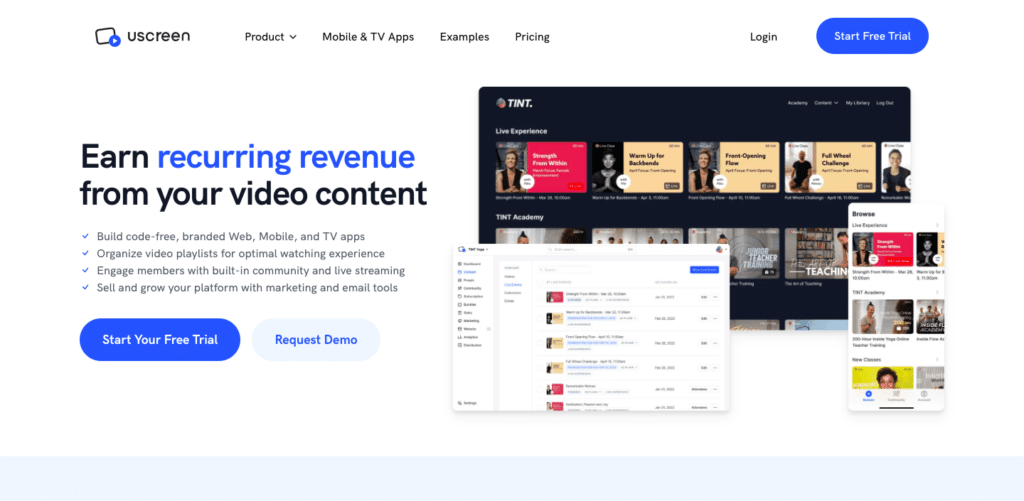
Pros:
- Tools to create a customized website with your own branding and domain name.
- Can host live streams.
- Create a completely brandable video player with up to 1080p quality.
- Filters for videos.
- Built-in video Content Management System (CMS) to store, upload, host, and organize videos in a single platform.
- Over 1,000 integrations.
- Marketing tools like discounts, gift cards, abandoned cart sequences, and discounts.
- Can sell content one-off, in a bundle, or via a membership.
Cons:
- Best features are only available with expensive plans.
- The current dashboard may feel too basic for advanced video content projects with fewer tools.
Pricing:
- Uscreen offers three pricing tiers: Basic ($79/month), Growth ($159/month), and Uscreen Plus (price on request).
Best For:
- Video creators who want to offer their content without building a custom website from scratch.
WordPress Sites as a Patreon Alternative for Full Control
WordPress is an excellent choice for creators looking for Patreon alternatives. With WordPress, creators can have complete freedom and control over their projects and content. They can create a complete website that reflects their personal brand instead of merely creating an account on some other platform.
They can even structure their own monetization strategy. For example, with various plugins and integrations, they can include a membership plugin for a subscriber model or an ecommerce plugin to sell products.

WordPress has about 55,000+ plugins. Plus, since it has a large user base, it’s easy to find themes, resources, and documentation if you run into any challenges.
Kinsta is a great cloud hosting platform if you use WordPress to host your content. We offer a wide array of features like:
- Google cloud platform infrastructure for reliable hosting.
- Automatic backups that reflect your latest updates.
- SSL certificates to safeguard your users’ data.
- CDN integration and built-in caching to improve your site’s speed and performance.
- A variety of pricing options to suit every need.
Which Patreon Alternative Should I Choose?
If you’re still not sure about which solution will work for you, here’s a short recap of our top four recommendations:
- Kickstarter: An excellent alternative for creators who want to crowdfund projects.
- Uscreen: The best video monetization platform.
- Sellfy: The best choice if you want to create an ecommerce digital storefront.
- WooCommerce: A great platform to sell your products on a WordPress site.
Most of these options are free Patreon alternatives or offer a free trial if you’d like to test out their features and decide what suits you best.
That said, see how Kinsta can help you manage web projects faster.


